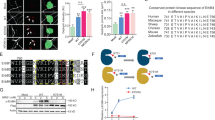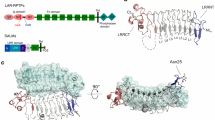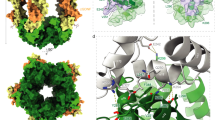Abstract
Synaptic cell adhesion molecules (CAMs) regulate synapse formation through their trans-synaptic and heterophilic adhesion. Here we show that postsynaptic netrin-G ligand (NGL) CAMs associate with netrin-G CAMs in an isoform-specific manner and, through their cytosolic tail, with the abundant postsynaptic scaffold postsynaptic density–95 (PSD-95). Overexpression of NGL-2 in cultured rat neurons increased the number of PSD-95–positive dendritic protrusions. NGL-2 located on heterologous cells or beads induced functional presynaptic differentiation in contacting neurites. Direct aggregation of NGL-2 on the surface membrane of dendrites induced the clustering of excitatory postsynaptic proteins. Competitive inhibition by soluble NGL-2 reduced the number of excitatory synapses. NGL-2 knockdown reduced excitatory, but not inhibitory, synapse numbers and currents. These results suggest that NGL regulates the formation of excitatory synapses.
This is a preview of subscription content, access via your institution
Access options
Subscribe to this journal
Receive 12 print issues and online access
$209.00 per year
only $17.42 per issue
Buy this article
- Purchase on Springer Link
- Instant access to full article PDF
Prices may be subject to local taxes which are calculated during checkout








Similar content being viewed by others
References
Li, Z. & Sheng, M. Some assembly required: the development of neuronal synapses. Nat. Rev. Mol. Cell Biol. 4, 833–841 (2003).
Waites, C.L., Craig, A.M. & Garner, C.C. Mechanisms of vertebrate synaptogenesis. Annu. Rev. Neurosci. 28, 251–274 (2005).
Washbourne, P. et al. Cell adhesion molecules in synapse formation. J. Neurosci. 24, 9244–9249 (2004).
Yamagata, M., Sanes, J.R. & Weiner, J.A. Synaptic adhesion molecules. Curr. Opin. Cell Biol. 15, 621–632 (2003).
Levinson, J.N. & El-Husseini, A. Building excitatory and inhibitory synapses: balancing neuroligin partnerships. Neuron 48, 171–174 (2005).
Craig, A.M., Graf, E.R. & Linhoff, M.W. How to build a central synapse: clues from cell culture. Trends Neurosci. 29, 8–20 (2006).
Dean, C. & Dresbach, T. Neuroligins and neurexins: linking cell adhesion, synapse formation and cognitive function. Trends Neurosci. 29, 21–29 (2006).
Akins, M.R. & Biederer, T. Cell-cell interactions in synaptogenesis. Curr. Opin. Neurobiol. 16, 83–89 (2006).
Biederer, T. et al. SynCAM, a synaptic adhesion molecule that drives synapse assembly. Science 297, 1525–1531 (2002).
Yamagata, M., Weiner, J.A. & Sanes, J.R. Sidekicks: synaptic adhesion molecules that promote lamina-specific connectivity in the retina. Cell 110, 649–660 (2002).
Ichtchenko, K. et al. Neuroligin 1: a splice site-specific ligand for beta-neurexins. Cell 81, 435–443 (1995).
Wu, Q. & Maniatis, T. A striking organization of a large family of human neural cadherin-like cell adhesion genes. Cell 97, 779–790 (1999).
Ichtchenko, K., Nguyen, T. & Sudhof, T.C. Structures, alternative splicing, and neurexin binding of multiple neuroligins. J. Biol. Chem. 271, 2676–2682 (1996).
Irie, M. et al. Binding of neuroligins to PSD-95. Science 277, 1511–1515 (1997).
Dean, C. et al. Neurexin mediates the assembly of presynaptic terminals. Nat. Neurosci. 6, 708–716 (2003).
Chih, B., Engelman, H. & Scheiffele, P. Control of excitatory and inhibitory synapse formation by neuroligins. Science 307, 1324–1328 (2005).
Graf, E.R., Zhang, X., Jin, S.X., Linhoff, M.W. & Craig, A.M. Neurexins induce differentiation of GABA and glutamate postsynaptic specializations via neuroligins. Cell 119, 1013–1026 (2004).
Scheiffele, P., Fan, J., Choih, J., Fetter, R. & Serafini, T. Neuroligin expressed in nonneuronal cells triggers presynaptic development in contacting axons. Cell 101, 657–669 (2000).
Nam, C.I. & Chen, L. Postsynaptic assembly induced by neurexin-neuroligin interaction and neurotransmitter. Proc. Natl. Acad. Sci. USA 102, 6137–6142 (2005).
Fu, Z., Washbourne, P., Ortinski, P. & Vicini, S. Functional excitatory synapses in HEK293 cells expressing neuroligin and glutamate receptors. J. Neurophysiol. 90, 3950–3957 (2003).
Levinson, J.N. et al. Neuroligins mediate excitatory and inhibitory synapse formation: involvement of PSD-95 and neurexin-1beta in neuroligin-induced synaptic specificity. J. Biol. Chem. 280, 17312–17319 (2005).
Hata, Y., Butz, S. & Sudhof, T.C. CASK: a novel dlg/PSD95 homolog with an N-terminal calmodulin-dependent protein kinase domain identified by interaction with neurexins. J. Neurosci. 16, 2488–2494 (1996).
Biederer, T. & Sudhof, T.C. Mints as adaptors. Direct binding to neurexins and recruitment of munc18. J. Biol. Chem. 275, 39803–39806 (2000).
Boucard, A.A., Chubykin, A.A., Comoletti, D., Taylor, P. & Sudhof, T.C. A splice code for trans-synaptic cell adhesion mediated by binding of neuroligin 1 to alpha- and beta-neurexins. Neuron 48, 229–236 (2005).
Tabuchi, K. & Sudhof, T.C. Structure and evolution of neurexin genes: insight into the mechanism of alternative splicing. Genomics 79, 849–859 (2002).
Rudenko, G., Nguyen, T., Chelliah, Y., Sudhof, T.C. & Deisenhofer, J. The structure of the ligand-binding domain of neurexin Ibeta: regulation of LNS domain function by alternative splicing. Cell 99, 93–101 (1999).
Chih, B., Gollan, L. & Scheiffele, P. Alternative splicing controls selective trans-synaptic interactions of the neuroligin-neurexin complex. Neuron 51, 171–178 (2006).
Graf, E.R., Kang, Y., Hauner, A.M. & Craig, A.M. Structure function and splice site analysis of the synaptogenic activity of the neurexin-1 beta LNS domain. J. Neurosci. 26, 4256–4265 (2006).
Song, J.Y., Ichtchenko, K., Sudhof, T.C. & Brose, N. Neuroligin 1 is a postsynaptic cell-adhesion molecule of excitatory synapses. Proc. Natl. Acad. Sci. USA 96, 1100–1105 (1999).
Varoqueaux, F., Jamain, S. & Brose, N. Neuroligin 2 is exclusively localized to inhibitory synapses. Eur. J. Cell Biol. 83, 449–456 (2004).
Prange, O., Wong, T.P., Gerrow, K., Wang, Y.T. & El-Husseini, A. A balance between excitatory and inhibitory synapses is controlled by PSD-95 and neuroligin. Proc. Natl. Acad. Sci. USA 101, 13915–13920 (2004).
Sara, Y. et al. Selective capability of SynCAM and neuroligin for functional synapse assembly. J. Neurosci. 25, 260–270 (2005).
Nakashiba, T. et al. Netrin-G1: a novel glycosyl phosphatidylinositol-linked mammalian netrin that is functionally divergent from classical netrins. J. Neurosci. 20, 6540–6550 (2000).
Nakashiba, T., Nishimura, S., Ikeda, T. & Itohara, S. Complementary expression and neurite outgrowth activity of netrin-G subfamily members. Mech. Dev. 111, 47–60 (2002).
Yin, Y., Miner, J.H. & Sanes, J.R. Laminets: laminin- and netrin-related genes expressed in distinct neuronal subsets. Mol. Cell. Neurosci. 19, 344–358 (2002).
Lin, J.C., Ho, W.H., Gurney, A. & Rosenthal, A. The netrin-G1 ligand NGL-1 promotes the outgrowth of thalamocortical axons. Nat. Neurosci. 6, 1270–1276 (2003).
Valtschanoff, J.G. & Weinberg, R.J. Laminar organization of the NMDA receptor complex within the postsynaptic density. J. Neurosci. 21, 1211–1217 (2001).
Kraszewski, K. et al. Synaptic vesicle dynamics in living cultured hippocampal neurons visualized with CY3-conjugated antibodies directed against the lumenal domain of synaptotagmin. J. Neurosci. 15, 4328–4342 (1995).
Horejsi, V. et al. GPI-microdomains: a role in signalling via immunoreceptors. Immunol. Today 20, 356–361 (1999).
Meerabux, J.M. et al. Human netrin-G1 isoforms show evidence of differential expression. Genomics 86, 112–116 (2005).
Comoletti, D. et al. Characterization of the interaction of a recombinant soluble neuroligin-1 with neurexin-1beta. J. Biol. Chem. 278, 50497–50505 (2003).
Hsueh, Y.P. & Sheng, M. Requirement of N-terminal cysteines of PSD-95 for PSD-95 multimerization and ternary complex formation, but not for binding to potassium channel Kv1.4. J. Biol. Chem. 274, 532–536 (1999).
Christopherson, K.S. et al. Lipid- and protein-mediated multimerization of PSD-95: implications for receptor clustering and assembly of synaptic protein networks. J. Cell Sci. 116, 3213–3219 (2003).
Jamain, S. et al. Mutations of the X-linked genes encoding neuroligins NLGN3 and NLGN4 are associated with autism. Nat. Genet. 34, 27–29 (2003).
Laumonnier, F. et al. X-linked mental retardation and autism are associated with a mutation in the NLGN4 gene, a member of the neuroligin family. Am. J. Hum. Genet. 74, 552–557 (2004).
Yan, J. et al. Analysis of the neuroligin 3 and 4 genes in autism and other neuropsychiatric patients. Mol. Psychiatry 10, 329–332 (2005).
Chih, B., Afridi, S.K., Clark, L. & Scheiffele, P. Disorder-associated mutations lead to functional inactivation of neuroligins. Hum. Mol. Genet. 13, 1471–1477 (2004).
Comoletti, D. et al. The Arg451Cys-neuroligin-3 mutation associated with autism reveals a defect in protein processing. J. Neurosci. 24, 4889–4893 (2004).
Chubykin, A.A. et al. Dissection of synapse induction by neuroligins: effect of a neuroligin mutation associated with autism. J. Biol. Chem. 280, 22365–22374 (2005).
Aoki-Suzuki, M. et al. A family-based association study and gene expression nalyses of netrin-G1 and -G2 genes in schizophrenia. Biol. Psychiatry 57, 382–393 (2005).
Acknowledgements
This work was supported by the National Creative Research Initiative Program of the Korean Ministry of Science and Technology (E.K.), and by grants from the Korea Science and Engineering Foundation (M10500000049-05J0000-04900 to H.K.) and the US National Institutes of Health (NS-39444 to R.J.W.).
Author information
Authors and Affiliations
Contributions
A.B. and R.J.W. performed the light and electron microscopic studies. H.S.C. and H.K. conducted the in situ hybridization analysis. S.-K.K. performed the in vivo coimmunoprecipitation. J.W. did the coclustering assay. H.W.L. and K.K. performed the northern blot analysis.
Note: Supplementary information is available on the Nature Neuroscience website.
Corresponding author
Ethics declarations
Competing interests
The authors declare no competing financial interests.
Supplementary information
Supplementary Fig. 1
Amino acid sequence alignment of NGL family proteins. (PDF 1845 kb)
Supplementary Fig. 2
Interaction between NGL and PSD-95. (PDF 727 kb)
Supplementary Fig. 3
NGL and netrin-G mediates cell adhesion in an isoform-specific manner. (PDF 773 kb)
Supplementary Fig. 4
Expression patterns of NGL mRNAs and proteins. (PDF 1651 kb)
Supplementary Fig. 5
Synaptic localization of NGL proteins in brain. (PDF 727 kb)
Supplementary Fig. 6
Polarized distribution of netrin-G2 to axons in cultured neurons. (PDF 577 kb)
Supplementary Fig. 7
Characterization of NGL-2 siRNA. (PDF 679 kb)
Rights and permissions
About this article
Cite this article
Kim, S., Burette, A., Chung, H. et al. NGL family PSD-95–interacting adhesion molecules regulate excitatory synapse formation. Nat Neurosci 9, 1294–1301 (2006). https://doi.org/10.1038/nn1763
Received:
Accepted:
Published:
Issue Date:
DOI: https://doi.org/10.1038/nn1763
This article is cited by
-
Cerebrospinal fluid camk2a levels at baseline predict long-term progression in multiple sclerosis
Clinical Proteomics (2023)
-
Whole genome sequencing identifies genetic variants associated with neurogenic inflammation in rosacea
Nature Communications (2023)
-
Molecular subtypes based on PANoptosis-related genes and tumor microenvironment infiltration characteristics in lower-grade glioma
Functional & Integrative Genomics (2023)
-
High-fat diet impairs duodenal barrier function and elicits glia-dependent changes along the gut-brain axis that are required for anxiogenic and depressive-like behaviors
Journal of Neuroinflammation (2021)
-
LRRC4 functions as a neuron-protective role in experimental autoimmune encephalomyelitis
Molecular Medicine (2021)



